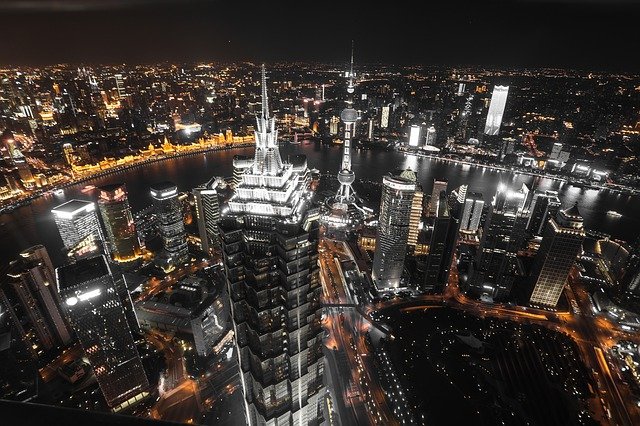By Tim Lambert
Early Shanghai
Shanghai is one of China’s great cities. By the 11th century AD, Shanghai was a small market town. It grew steadily larger, and in 1403, the City God Temple of Shanghai was built. In 1533, a wall was built around the town. In 1559, Yu Gardens was created. By 1700, Shanghai had a population of about 50,000, making it a large and prosperous port.
Then, in 1842, by the Treaty of Nanking, the British forced China to open 5 ports, including Shanghai, for trade. In 1843, the first British consul moved into Shanghai.
In the 19th century, foreigners in Shanghai lived in three settlements. From 1845, a British settlement existed, followed by an American settlement after 1848 and a French settlement after 1849. In 1863, the British and American settlements later merged to form the International Settlement, while the French concession remained separate.
At first, tea, silks, and porcelain were exported from Shanghai while opium was imported. Later, Shanghai became a major financial center, and banking was an important sector. There was also a large textile industry in Shanghai.
Jade Buddha Temple in Shanghai was founded in 1882.
Meanwhile, in 1866, the city gained gaslight. Electricity was first generated in Shanghai in 1882. In 1908, the first cinema was built in Shanghai, and electric trams began running in the streets. By 1900, Shanghai had grown enormously to be a city of 1 million. Then in 1912, the old city walls were demolished.
Meanwhile, Western missionaries preached Christianity in Shanghai. St Ignatius Cathedral was built in 1904.
20th Century Shanghai
In the early 20th century, many notable buildings were erected in Shanghai. The Shanghai Pudong Development Bank was built in 1921. The HSBC Building followed in 1923. The North China Daily News Building was built in 1924. Also in 1924, the Wukang Mansion was built.
The Customs House was built in 1927. The Peace Hotel was built in 1929. Shanghai Park Hotel followed in 1934. The Bank of China Building in Shanghai was built in 1937.
However, all was not well in Shanghai. In 1925, there was labor unrest and strikes. Then in 1927, Chiang Kai-shek, the Nationalist leader, captured Shanghai.
By the mid-1930s, Shanghai was a huge city with a population of about 3 million. Many foreigners lived there, including Russians who fled from the Revolution. However, in 1937, the Japanese invaded China, and in November, they captured Shanghai.
In the 1930s, more than 20,000 Jews fled to Shanghai, one of the few places that granted them refuge. However, during the Second World War, the Japanese forced them into a ghetto. Yet most survived the Second World War and left afterwards. In 1943, theJapanese rounded up other foreigners in Shanghai and marched them off to prison camps.
In 1943, Britain and the USA signed a treaty returning their settlements in Shanghai to Chinese rule.
In May 1949, the Communists entered Shanghai. Under their rule, the city remained a major industrial center, and by the early 1980s, Shanghai had a population of 13 million.
Shanghai Museum opened in 1952. Also in 1952 Shanghai Library was founded. The Shanghai Exhibition Centre was built in 1955. The China Art Museum was founded in 1956. Shanghai Natural History Museum was also founded in 1956. The Shanghai Botanical Garden was created in 1974.
In the 1990s and the early 21st century, Shanghai boomed. Its industries flourished, and many new high-rise buildings were erected. The population of Shanghai also rose rapidly as the city grew rich.
Shanghai History Museum was founded in 1983. The Shanghai Metro opened in 1993. Oriental Pearl Tower was built in 1994, and Jin Mao Tower followed in 1999.
21st Century Shanghai
In the 21st century, Shanghai flourished as a financial centre. The Shanghai World Financial Centre was built in 2008.
Meanwhile, the Shanghai Maglev Train opened in 2004. The Shanghai Jewish Refugees Museum opened in 2007.
Then in 2010, the World Expo was held in Shanghai. The same year, 2010 Minsheng Art Museum opened. Hongqiao railway station also opened in 2010. Shanghai Tower was built in 2015.

Today, Shanghai is a thriving city. It is also one of the largest cities in the world. In 2024, Shanghai had a population of 24 million.
Last revised 2025